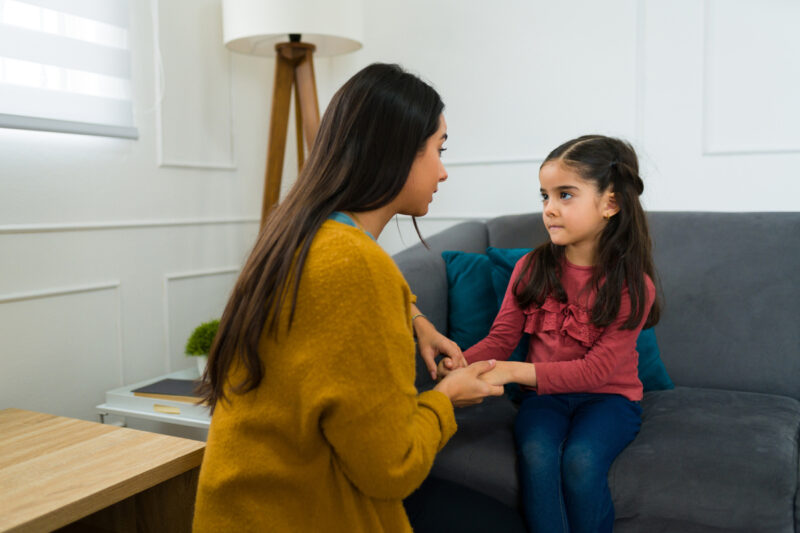Making the decision to divorce is likely difficult, especially for parents who are concerned about the impact the process and subsequent changes will have on their children. While children of divorced parents may face a higher risk of emotional difficulties, academic struggles, and relationship challenges compared to those from intact families, when parents remain in a high-conflict or unhappy marriage, children can also be negatively affected (Amato, 2010). Despite its challenges, divorce can sometimes lead to positive outcomes for children and the family, including reduced household tension, happier parents, improved parenting dynamics, stronger role models, and greater resilience and independence (Hetherington, 2006).
Children can experience divorce in similar and in different ways. As a parent, you can help your child process their emotions and cope with the changes they will face during the divorce in a way that is developmentally appropriate and in a way that can support their overall well-being. Let’s examine some strategies that parents and caregivers can use to support children of all ages.
Limit your child’s exposure to parental conflict.
Children will generally adjust more easily to the divorce or separation when parents manage their conflicts privately and avoid exposing their children to parental negativity during and after divorce (Kleinsorge & Covitz, 2012). Try to use respectful language and tone when interacting with or speaking about your coparent in front of your child and refrain from making negative comments about the other parent.
Provide consistency.
Divorce will create changes and probably some distress for children, and you, as a parent, may feel tempted to relax rules or indulge your child to ease their concerns. However, doing this can make it difficult for you to enforce or reinstate boundaries later. To provide stability for your family, maintain consistent rules, discipline, and routines across both households. Try to keep your child’s daily life—school, friends, and environment—as unchanged as possible. In addition, keeping and using regular schedules for meals, chores, and bedtime can give your child a sense of predictability and security.
Respect the relationship between your child and their other parent.
If your child’s other parent is able to meet your child’s needs consistently and is capable of maintaining your child’s well-being, support your child’s relationship with their other parent. Reassure your child that they are loved and will be cared for by both parents. Maintain your bond with your child, and encourage them to maintain their bond with their other parent. Remember to avoid letting your own personal differences interfere in your child’s relationship with their other parent. Remind your child that both of their parents love them even if they only live with one at a time. If you won’t be living with your child after your divorce, keep your promises to visit and spend time together.
Manage your stress and other emotions.
Children can sense your emotions, and sensing your stress may result in your child reacting unpredictably. When you are with your child, there are strategies you can use to help you stay calm, regulate your emotions, and refocus. Try simple techniques like counting to 10 before reacting to a situation or saying something or taking deep, slow breaths. If emotions run high, it’s okay to take a short break—just ensure your child is safe first (e.g., place a young child in a crib or playpen).
Seek professional support.
During the divorce process, you may have trouble determining if your child’s behavior is developmentally appropriate or a sign that your child is struggling. If your child is experiencing significant emotional or behavioral challenges, speak with your child’s healthcare provider. You may also want to seek support from a counselor or behavioral health professional who can help your child process their feelings and learn coping strategies that they can use to help them manage their emotions. Consider professional support, especially if parental conflict is high, or a parent is struggling with depression or mental illness.
A child’s awareness of changes related to their parents’ divorce and understanding of the divorce process will depend on their age and stage of cognitive development. To learn about age-specific impacts and strategies that can be used to support children who are experiencing their parents’ divorce, participate in the Divorce: Parenting Through Differences supplemental module on the Thrive website.
References
Amato, P. R. (2010). Research on divorce: Continuing trends and new developments. Journal of Marriage and Family, 72(3), 650-666. https://doi.org/10.1111/j.1741-3737.2010.00723.x
Clearinghouse for Military Family Readiness at Penn State. (2024, October). Maintaining child well-being during divorce [Session 5 of the Divorce: Parenting through Differences. Online Curricula]. Clearinghouse for Military Family Readiness at Penn State.
Hetherington, E. M. (2006). The influence of conflict, marital problem solving and parenting on children’s adjustment in nondivorced, divorced, and remarried families. In A. Clarke-Stewart & J. Dunn (Eds.), Families count: Effect on child and adolescent development (pp. 203–237). Cambridge University Press.
Kleinsorge, C., & Covitz, L. M. (2012). Impact of divorce on children: Developmental considerations. Pediatrics in Review, 33(4), 147-155. https://doi.org/10.1542/pir.33-4-147

